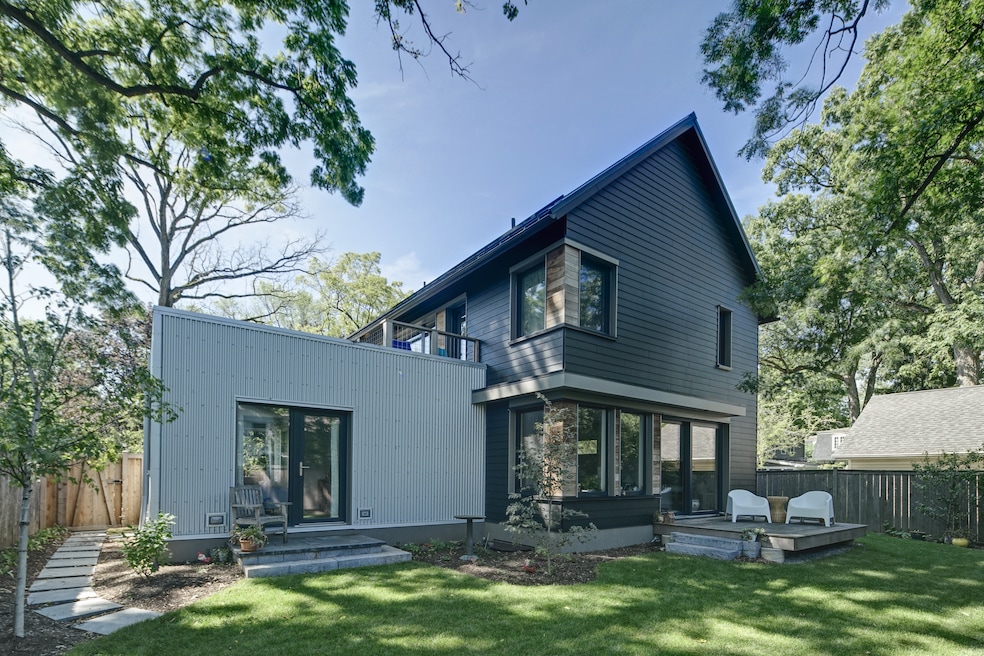Considering a gothic-looking black-exterior home? The outside gets hot to the touch, but by taking some precautions, owners can stay cool inside, avoiding any gloom and doom when it comes to comfort.
Dark monochromatic siding has become increasingly popular in recent years, though still trailing behind the popular whites and light browns, construction professionals say. The trend follows the move toward color-drenched interiors, where hues embrace moodier tones.
“We’ve seen a little more openness to it as a strong aesthetic choice,” said architect Tom Bassett-Dilley of Tom Bassett-Dilley Architects in Oak Park, Illinois. “In recent years, there were a ton of white ‘modern farmhouses.’ I don’t know if the black exteriors are a reaction to that, but I think they have some interesting precedence.”
It’s a basic fact of science that most people learn in elementary school: Dark colors absorb heat while light colors reflect it. The effect is felt when wearing a dark T-shirt on a summer day or touching a white car after it’s been out in the sun.
When it comes to homes, yes, a black exterior will be hot, but there are ways to keep energy costs low and interiors comfortable.
Bassett-Dilley starts a new custom home project by using energy modeling software METr by Phius, a nonprofit that certifies so-called passive houses. These structures use design principles to achieve optimal temperatures while reducing the reliance on mechanical heating and cooling. The Passive House Institute in Darmstadt, Germany, established the standards for the building type in 1996.
Bassett-Dilley’s software spits out the energy performance and usage of each home depending on its features and construction, such as the type of siding it will have. “What I found is that it has a very, very little impact on the performance of the home if the home is really well insulated,” he said.
That means the exterior color should have little impact on the temperature inside as long as there are no leaky windows — or holes in the perimeter — that let heat enter.

Insulation is key
In Naperville, Illinois, Kevin Kittilsen, vice president of DJK Custom Homes, uses continuous insulation in every home he builds, even those with black siding.
“You’re essentially wrapping the entire home in a blanket,” he said.
On a hot sunny day, continuous insulation keeps out the heat absorbed from an all-black exterior by preventing it from moving into the home.
Continuous insulation goes beyond code requirements. While the approach is gaining popularity in the construction industry, Kittilsen said, it remains a best practice rather than a standard. The most common method today is installing insulation within a home's wall cavities.
In this method, what’s known as batt insulation is fitted between the boards of a house’s framing. The wooden studs are not insulated and touch a home’s walls, creating a so-called thermal bridge, or a section where heat can move through.
“There’s so many pieces to the puzzle, regardless of whether the home is black or white, everything we’re doing is still important,” said Kittilsen. “Say, ‘Hey, aside from nice quartz countertops and plumbing fixtures I’m selecting, what’s between the walls? What are you using? How are you air sealing? "
In addition to insulation, Bassett-Dilley’s team opts to add ventilation space between the home’s exterior walls and the siding if using exterior wood products such as LP SmartSide, or popular cement fiber boards from James Hardie.
“If it heats up, [the siding] is open at the bottom and open at the top — with a screen to keep bugs out — but that lets air move through there and ventilate and lets moisture out,” Bassett-Dilley said. “If it gets hotter because it’s absorbing more sunlight, most of that is released in that ventilation cavity.”
Paired together, the difference in energy use between a black-clad home and a white one is “negligible,” he said.
Paint it black?
Contractors most often install continuous insulation and ventilated siding during new construction or a pricey re-siding project. Owners of older existing homes can participate in the black exterior trend. Painting is an option, but they should still have their insulation checked.
“Their home might already be losing a lot of cooling to the outdoors, then you add in painting the house black and having that heat absorption through the home, it would amplify the effects of poorly insulated walls or a leaky home,” said Kittilsen.
If an existing home has brick siding, Bassett-Dilley recommends considering the type of paint used on the masonry. Brick absorbs moisture, so it cannot be painted with traditional latex paint, or moisture will be trapped.
Other considerations
A black exterior home has a strong shot at staying cool in the sun, but the pros warn that dark siding is more subject to color fading and noticeable imperfections, such as splashback from rain.
A home with black metal siding is prone to common warping due to natural expansion and contraction, called oil canning, according to Bassett-Dilley. The effect, also seen with metal roofs, creates a “wavy” or “buckled” appearance.
“This has driven a number of our clients nuts,” he said.
Both Kittilsen and Bassett-Dailey agreed that a home’s optimal performance and energy use is about more than just the exterior color. Ensuring indoor comfort requires a whole-home approach, looking at the function of each feature, including insulation, windows and their orientation, and how they interact.
The type, size and shading of windows, for instance, will be “far more impactful than the siding,” said Bassett-Dilley.
